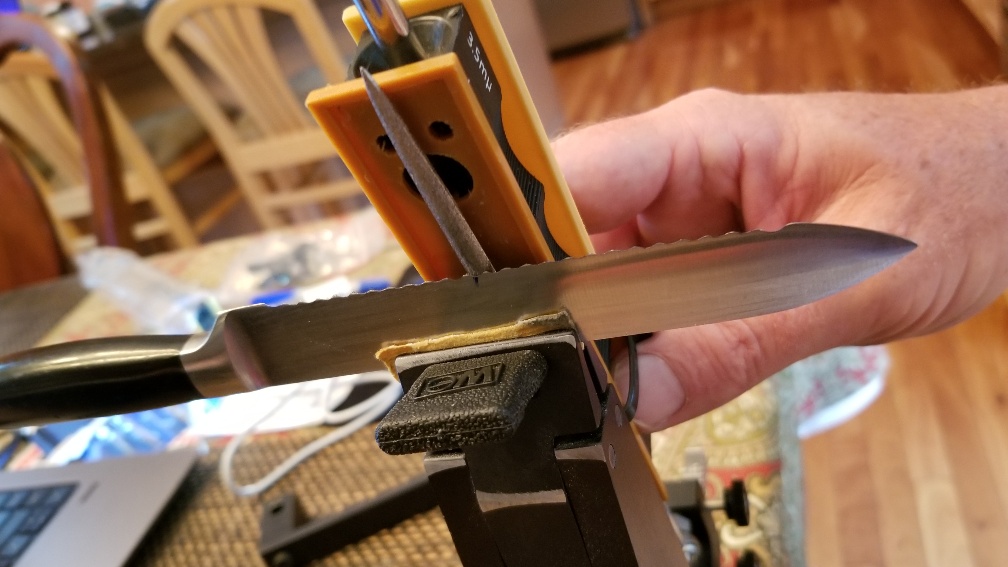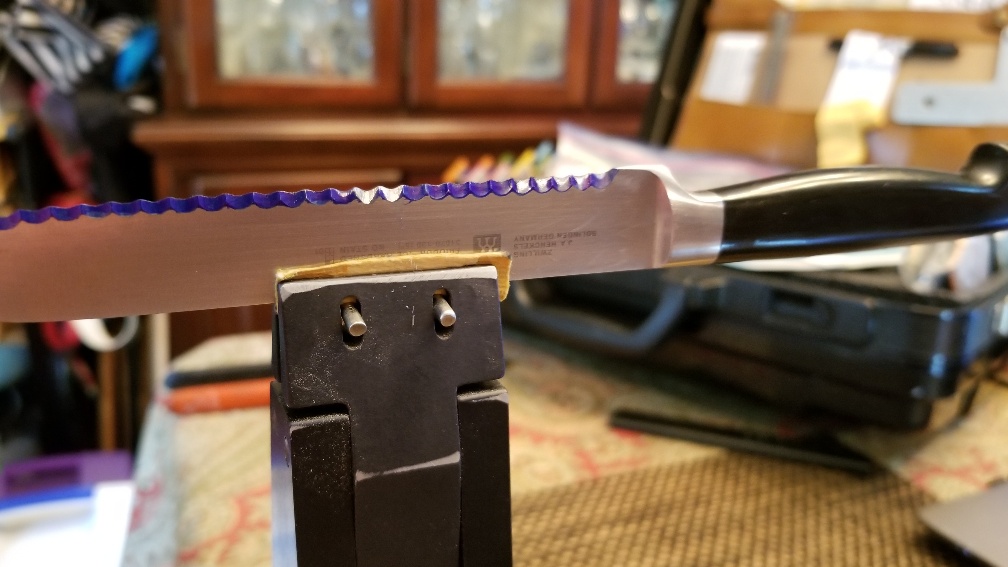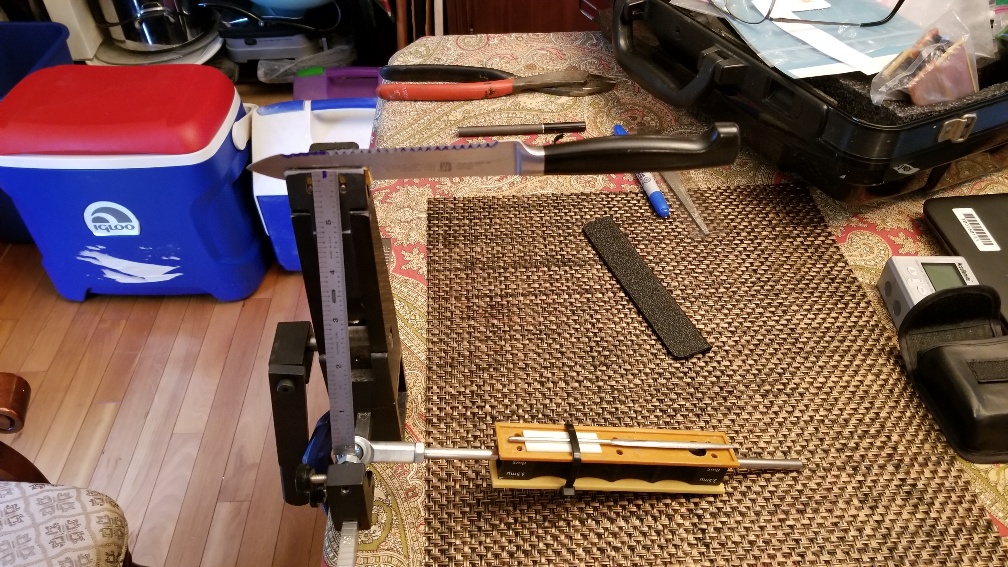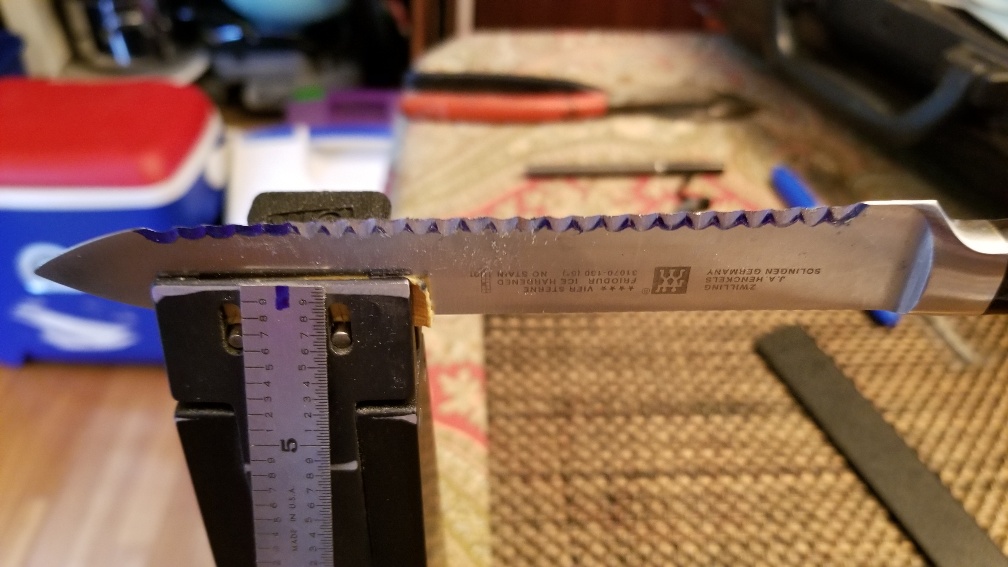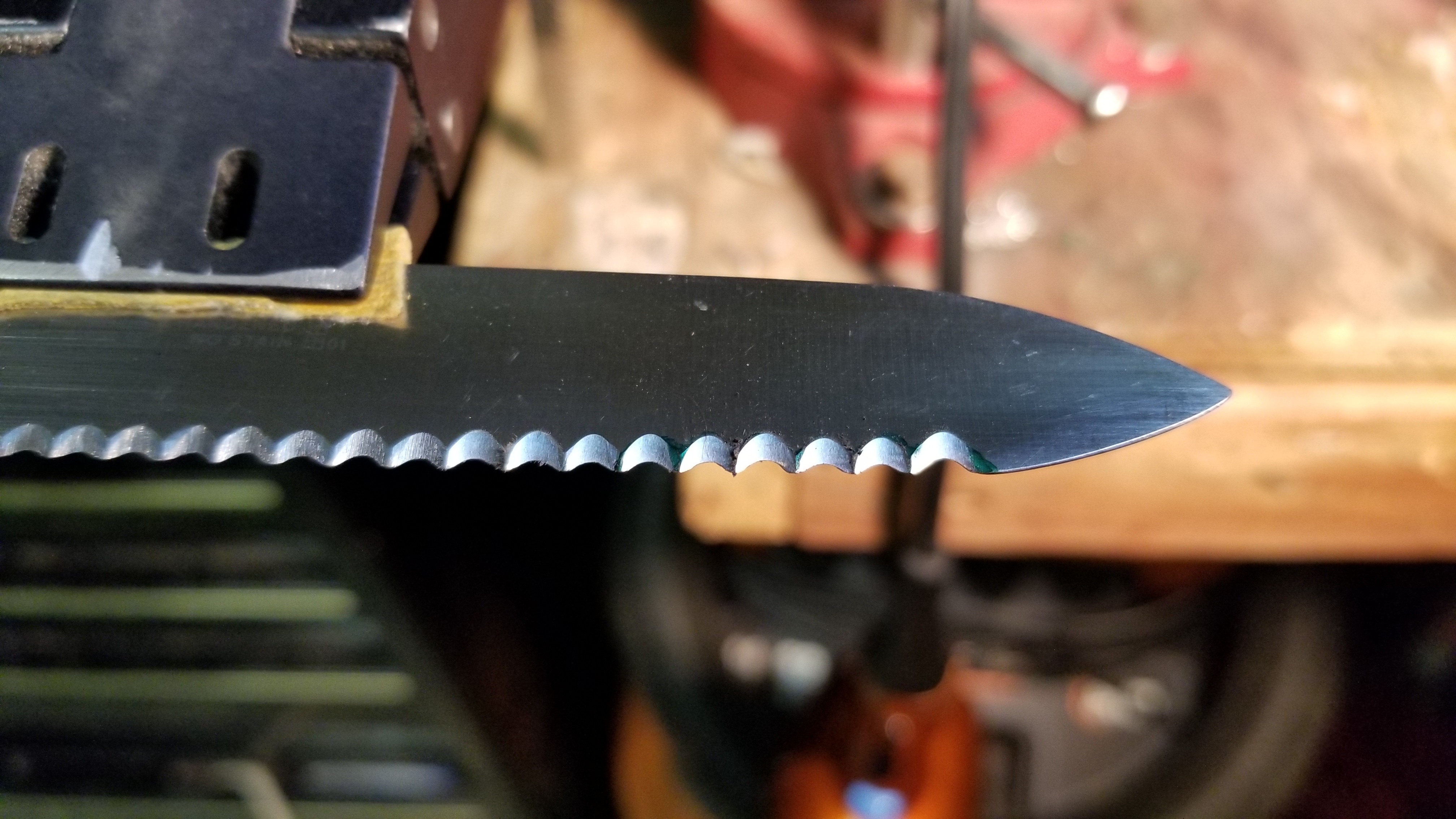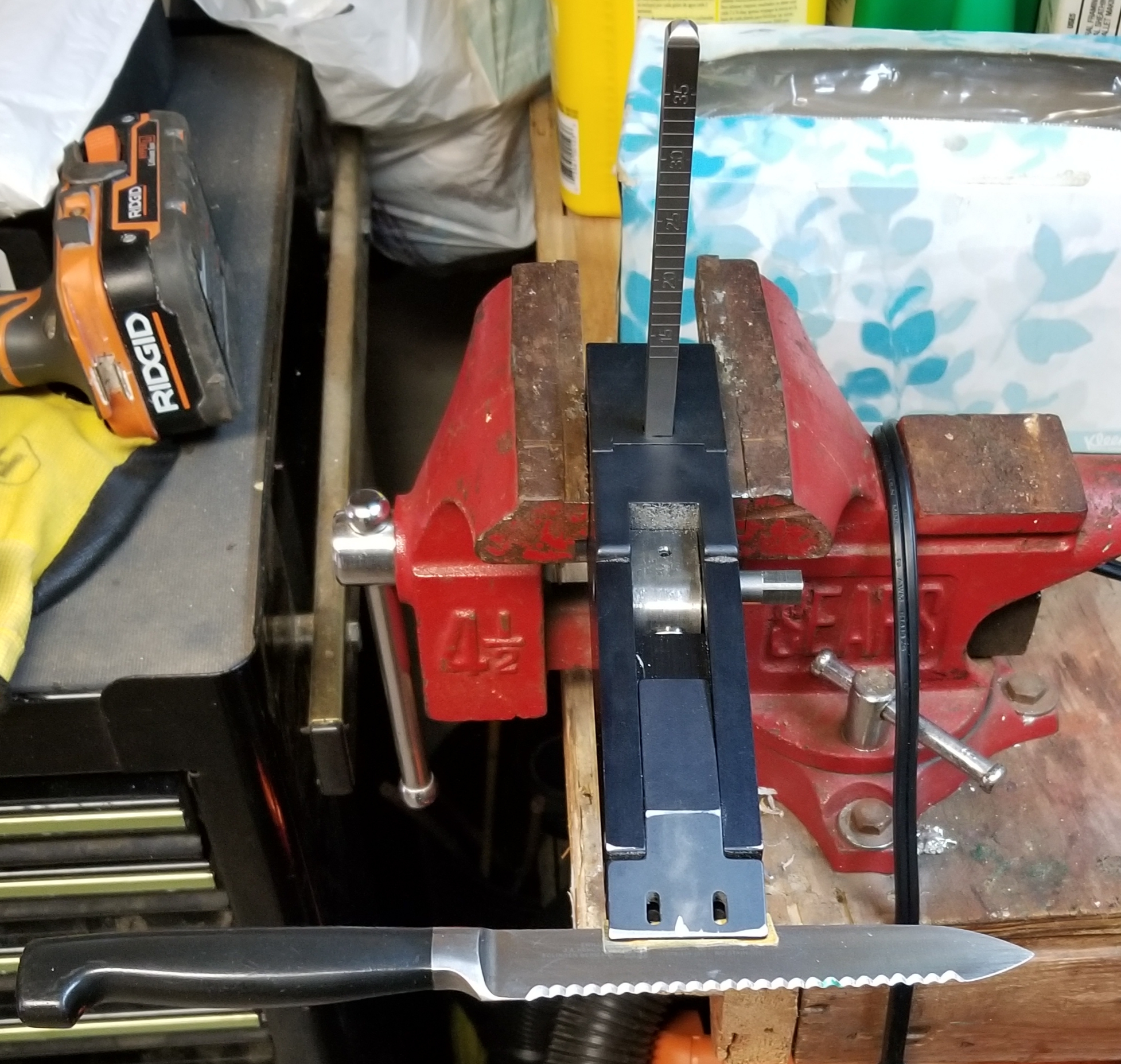Serrated Knife Experiment
Recent › Forums › Main Forum › Serrated Knife Experiment
- This topic has 7 replies, 4 voices, and was last updated 08/21/2018 at 8:32 pm by
Readheads.
-
AuthorPosts
-
08/19/2018 at 8:29 pm #47356
Just sharing, I rigged up a half round diamond file (grit 100-200) to a WEPS paddle to try and reprofile my small serrated knife. There are 25 serrations and the knife must be moved each time to center (by eye) each serration. I used the height key as a guide and kept the knife touching it at each move. Angle is 18 deg, single sided serration. It worked better than I thought it would. The strokes are up and down only. The diamond file reprofiled with nice burr after about 100+ strokes in a minute for each serration. Unfortunately, I am limited to the grits available and half round sizes. I have seen the cones available but IMO repeatability suffers. Also, the burr was a real PIA to remove, I used my finger nail and the edge of leather to do it. The knife is very sharp but it’s only at 100-200 grit (very coarse) but maybe appropriate for serrated knifes. Anyway, just throwing it out there for comments as I thing WEPS is trying to come up with something to help — need linear progression and diamond files.
Attachments:
You must be logged in to access attached files.
4 users thanked author for this post.
08/19/2018 at 8:31 pm #47362One more pic
Attachments:
You must be logged in to access attached files.
2 users thanked author for this post.
08/19/2018 at 9:08 pm #47364You might try using a round chop stick, (used for eatting Chinese food), just like you’re using the file. You can pull across the serrations, successively finer grit sand papers or emery cloth that you have wrapped up over the chop stick and held in place with your fingers on the stone. This should allow you to finish the edge to a smoother surface.
The problem or difficulty with serrated edges are, they’re like hand turned stairway balusters, or hand turned table legs, there aren’t that many stairways or tables that are the same. A tool that sharpens one serrated edge won’t necessarily match another makers serrated edge. Some serrated edges are proprietary and limited to only one particular knife edge.
Marc
(MarcH's Rack-Its)3 users thanked author for this post.
08/20/2018 at 3:00 am #47367I was going to suggest that you use a VEFF sharpener tool, but I see they’ve discontinued it and it’s out of stock on Amazon. Here’s the CRKT page for it.
I see that there are a few for sale on Ebay, but the ones I checked were out of stock too. You might find someone on the various knife forums who might part with a set. Sorry, but I’ll keep mine.
It’s a kit of two 600-grit diamond rods, each with three different diameters. The rods fit a metal handle, also supplied, much like a rifle cleaning rod.
The VEFF Sharp was sold by Columbia River Knife & Tool – CRKT – not to be confused with the CRK (Chris Reeves Knives) mentioned here recently. The name VEFF comes from its inventor, Tom Veff.
Another workable trick I’ve used is to chuck up a ceramic rod in a cordless drill. I then spin the rod with the drill while holding it in each serration groove. If you have a knife with rather large serrations, this works beautifully. No reason why the VEFF rods wouldn’t work in a drill. Years ago I bought a kit of very small Arkansas stones to use when tuning up the working parts of rifles and handguns, particularly Smith & Wesson revolvers. I still have a few remnants of an Arkansas stone in small-diameter (about 5/16″??) rod form from that kit and this has worked well in the drill too. I only have a few pieces left.
Small serrations are still problematic. I haven’t tried it yet, but I think a thin disc (1/4″??) cut from MDF or hardboard (underlayment) and profiled to have a sharp “V” edge would take polishing compound well enough to work the narrow serrations. Of course, this would mount on a motor shaft and you’d hold the knife so as to work the “V” and its compounds into the serration grooves.
A few years ago, I made a jig using a 3/4″ linear bearing on a section of precision-ground rod. It was located roughly where the ball joint would be and ran parallel to the blade. There was no swivel action as the stone (SharpMaker Triangle) moved only vertically. I never finished it, as the need dropped it way down the to-do list. It dropped even father when I went to the Gen 3 Pro, which wasn’t compatible. Maybe I ought to resurrect it. The advantage was that you didn’t have to move the knife with each serration.
-
This reply was modified 7 years ago by
 tcmeyer.
tcmeyer.
3 users thanked author for this post.
08/20/2018 at 3:16 am #47368I just visited Rockler.com, which is a woodworking supplier. As I was looking for wheels to replace the junk on my old table saw, I came across this. A leather wheel used to sharpen inside corners of carving tools. Pretty pricey at $67, but this is what I was referring to with the MDF idea.
1 user thanked author for this post.
08/20/2018 at 10:28 am #47380Thanks for sharing your work. It looks like the results were very nice, but I can imagine that the time it took to complete the knife was not insignificant. The best solutions I have seen for sharpening serrations are both powered options: a compound loaded wheel mounted to a bench grinder and using the edge of a belt sander. Neither option is a fixed angle solution.
1 user thanked author for this post.
08/21/2018 at 8:14 pm #47428I am happy with the serrated results, but the only grit I had was 100-200 diamond. I remembered that I have a ceramic 0.25″ diameter sharpening rod of ~600 grit (I think). I put the WEPS on its side in my vise (as it holds knives beautifully) and went at it free hand. It worked pretty good and the surface finish difference is easy to see in the 9 scallops near the tip. After setup it took less than 30 minutes for the 25 scallops. The resulting burrs were challenging.
My goal is to handle 90%+ of serrations including Jay Fisher’s. My vision is to bring fixed repeatable angles with 4 grits (100, 600, 1000, 1500) into play with standard cam WEPS. I accept the fact that I need to reposition the blade for each scallop because it’s not too bad with the cam release and riding the 2 pegs of the height key. I can also deal with that later. What I need is:
1. Diamond rods of 5 diameters in inches (1/8, 1/4, 3/8, 1/2, 5/8) each in grits of 100, 600, 1000, 1500. DMT is the closest I can find but I don’t like the cones (violates fixed angle).
2. A method of mounting these diamond rods concentric to the WEPS rods so they will slide up and down as well as rotate. The WEPS rods will have to be much shorter with a stop to keep the diamond rods from pulling off.
Attachments:
You must be logged in to access attached files.
3 users thanked author for this post.
08/21/2018 at 8:32 pm #47431 -
This reply was modified 7 years ago by
-
AuthorPosts
- You must be logged in to reply to this topic.
